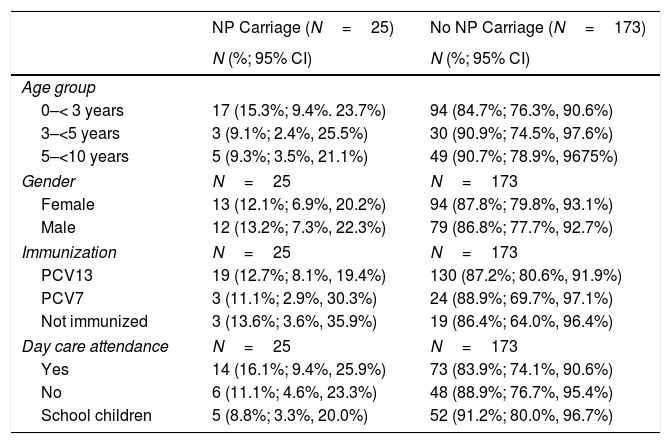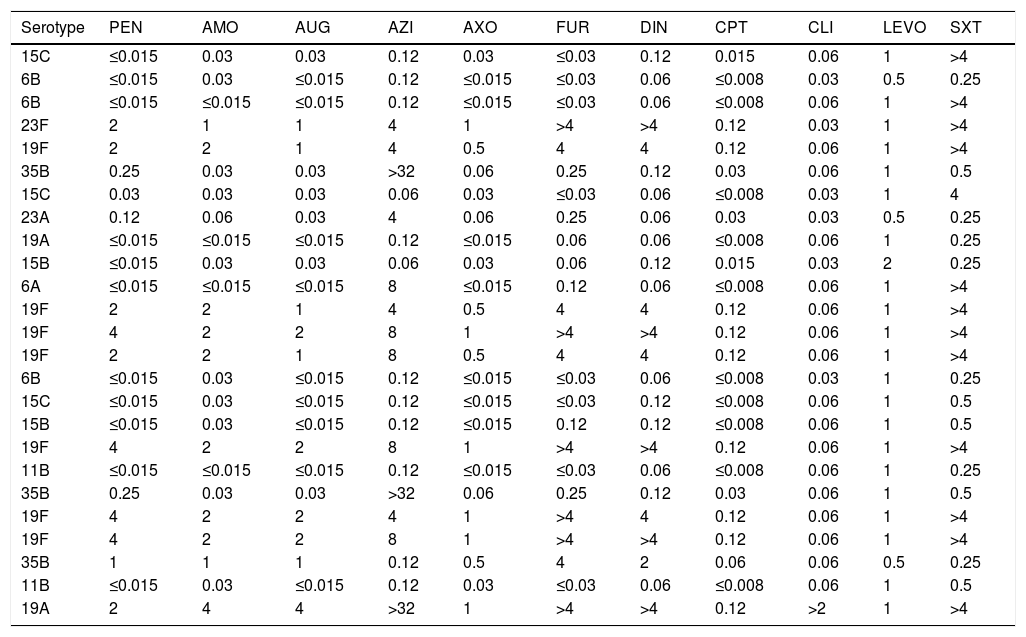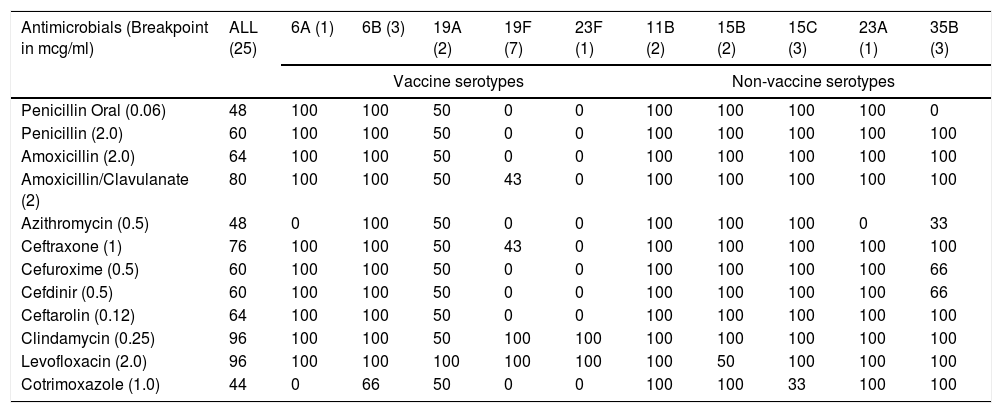Barbados like other countries in the English-speaking Caribbean introduced the 7-valent pneumococcal conjugate vaccine (PCV7) in late 2007, replaced by the 13-valent vaccine (PCV13) in 2013, using a 3+ 0 dosing schedule. We investigated the prevalence and serotype pattern of nasopharyngeal (NP) carriage of Streptococcus pneumoniae (SP) and the Antimicrobial Non-susceptibility of SP (ANSP) among children.
Materials and methodsA cross sectional survey of NP carriage. NP swabs were collected from healthy children (6 months to 10 years) attending the well-child clinic at the polyclinics, after parental consent, during 2016–2017. Samples were cultured for SP and isolates were serotyped by the capsular swelling method using commercial group- and type-specific sera. Susceptibility testing was conducted by broth microdilution MIC determination, according to CLSI recommended breakpoints.
ResultsPrevalence of NP carriage of SP among 198 healthy children, 88.9% immunized for PCV, was 12.6% (95% CI=8.5%, 18.3%). Prevalence of NP carriage for the VT and NVT was 7.1% (95% CI=4.1%, 11.8%) and 5.6% (95%CI=3.0%, 10.0%) respectively. Serotype 19F was the most common NP isolate in 7 (28%; 12.9%, 49.6%) children and this was followed by 15B/C (25%), 35B (12%) and 6B (12.5%). More than 50% of isolates exhibited Antimicrobial Non-sensitive SP (ANSP) to Penicillin (Oral), Azithromycin and Co-trimoxazole. Serotypes 19F, 19A and 23F showed high level ANSP to 10/11 commonly used antibiotics.
ConclusionsNP carriage of SP among healthy children immunized with PCV continues to be predominantly VT and exhibit high ANSP.
Barbados, al igual que otros países de la región caribeña de habla inglesa, introdujo la vacuna conjugada antineumocócica PCV7 a finales de 2007, sustituida por la vacuna conjugada antineumocócica PCV13 en 2013, utilizando un programa de dosificación 3+ 0. Investigamos la prevalencia y el patrón serotípico de la colonización nasofaríngea (CN) de Streptococcus pneumoniae (SP), así como la insensibilidad antimicrobiana de SP (ANSP) entre los niños.
Materiales y MétodosEstudio transversal de colonización nasofaríngea. Se recogieron las torundas nasofaríngeas de niños sanos (de 6 meses a 10 años) que acudieron a la clínica infantil del policlínico, tras obtener consentimiento parental, durante 2016 y a lo largo de 2017. Se realizó un cultivo a las muestras para SP, serotipándose los aislamientos mediante el método de hinchazón capsular, utilizando sueros comerciales específicos de grupo y tipo. Se realizó la prueba de susceptibilidad mediante cálculo de MIC aplicando el método de microdilución en caldo, conforme a los puntos de ruptura recomendados por CLSI.
ResultadosLa prevalencia de colonización nasofaríngea de SP entre 198 niños sanos, de los cuales el 88,9% estaba inmunizado con PCV, fue del 12,6% (95% IC=8,5%, 18,3%). La prevalencia de colonización nasofaríngea para VT y NVT fue del 7,1% (95% IC=4,1%, 11,8%) y 5,6% (95%IC=3%, 10%) respectivamente. El serotipo 19F fue el aislamiento nasofaríngeo más común en 7 niños (28%; 12,9%, 49,6%), seguido de 15B/C (25%), 35B (12%) y 6B (12,5%). Más del 50% de los aislamientos reflejaron la insensibilidad antimicrobiana de SP (ANSP) a la Penicilina (Oral), Azitromicina y Co-trimoxazol. Los serotipos 19F, 19A y 23F reflejaron un alto nivel de ANSP a 10/11 antibióticos de uso común.
ConclusionesLa colonización nasofaríngea de SP entre niños sanos inmunizados con PCV sigue estando predominantemente presente en VT, y muestra un alto nivel de ANSP.









